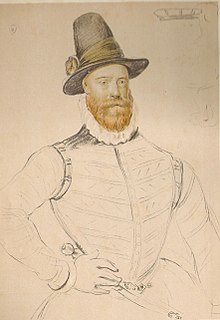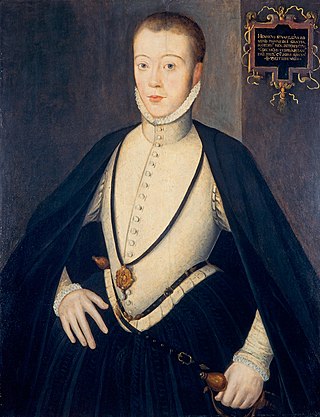
Henry Stuart, Lord Darnley, was the second husband of Mary, Queen of Scots, and the father of James VI of Scotland and I of England. Through his parents, he had claims to both the Scottish and English thrones, and from his marriage in 1565 he was king consort of Scotland. Less than a year after the birth of his son, Darnley was murdered at Kirk o' Field in 1567. Many contemporary narratives describing his life and death refer to him as simply Lord Darnley, his title as heir apparent to the Earldom of Lennox.
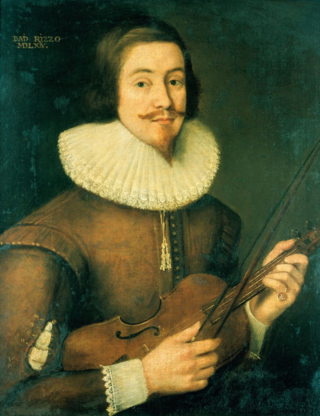
David Rizzio or Riccio was an Italian courtier, born in Pancalieri close to Turin, a descendant of an ancient and noble family still living in Piedmont, the Riccio Counts di San Paolo e Solbrito, who rose to become the private secretary of Mary, Queen of Scots. Mary's husband, Lord Darnley, is said to have been jealous of their friendship because of rumours that Rizzio had impregnated Mary, and he joined in a conspiracy of Protestant nobles to murder him, led by Patrick Ruthven, 3rd Lord Ruthven. Mary was having dinner with Rizzio and a few ladies-in-waiting when Darnley joined them, accused his wife of adultery and then had a group murder Rizzio, who was hiding behind Mary. Mary was held at gunpoint and Rizzio was stabbed numerous times. His body took 57 dagger wounds. The murder was the catalyst of the downfall of Darnley, and had serious consequences for Mary's subsequent reign.

The House of Stuart, originally spelled Stewart, was a royal house of Scotland, England, Ireland and later Great Britain. The family name comes from the office of High Steward of Scotland, which had been held by the family progenitor Walter fitz Alan. The name Stewart and variations had become established as a family name by the time of his grandson Walter Stewart. The first monarch of the Stewart line was Robert II, whose male-line descendants were kings and queens in Scotland from 1371, and of England, Ireland and Great Britain from 1603, until 1714. Mary, Queen of Scots, was brought up in France where she adopted the French spelling of the name Stuart.
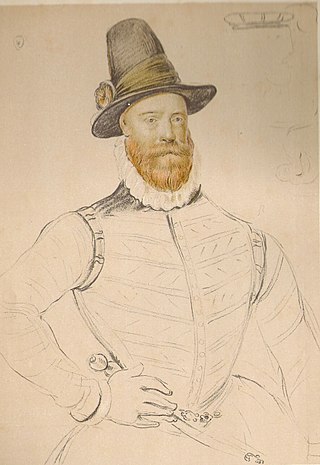
James Douglas, 4th Earl of Morton was a Scottish nobleman. He played a leading role in the murders of Queen Mary's confidant, David Rizzio, and king-consort Henry Darnley. He was one of the last of the four regents of Scotland during the minority of James VI and I. He was in some ways the most successful of the four, since he won the civil war that had been dragging on with the supporters of the exiled Mary, Queen of Scots. However, he came to an unfortunate end, executed by means of the Maiden, a predecessor of the guillotine.
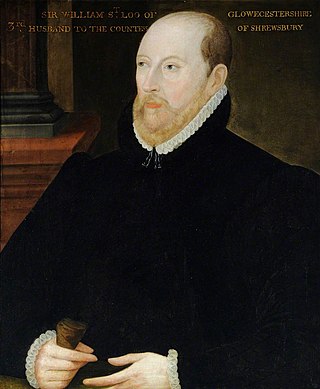
Matthew Stewart, 4th Earl of Lennox was a leader of the Catholic nobility in Scotland. He was the paternal grandfather of King James VI of Scotland. He owned Temple Newsam in Yorkshire, England.

The Earl or Mormaer of Lennox was the ruler of the region of the Lennox in western Scotland. It was first created in the 12th century for David of Scotland, Earl of Huntingdon and later held by the Stewart dynasty.
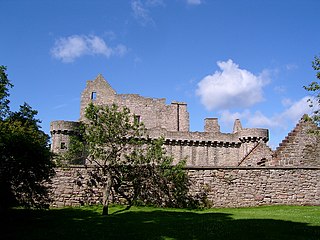
Craigmillar Castle is a ruined medieval castle in Edinburgh, Scotland. It is three miles (4.8 km) south-east of the city centre, on a low hill to the south of the modern suburb of Craigmillar. The Preston family of Craigmillar, the local feudal barons, began building the castle in the late 14th century and building works continued through the 15th and 16th centuries. In 1660, the castle was sold to Sir John Gilmour, Lord President of the Court of Session, who breathed new life into the ageing castle. The Gilmours left Craigmillar in the 18th century for a more modern residence, nearby Inch House, and the castle fell into ruin. It is now in the care of Historic Environment Scotland as a scheduled monument, and is open to the public.

Sir James Montgomery, 1st Baronet Stanhope, FRSE was a Scottish advocate, judge, country landowner, agriculturalist and politician who sat in the House of Commons from 1766 to 1775. In 1783 he was a joint founder of the Royal Society of Edinburgh.
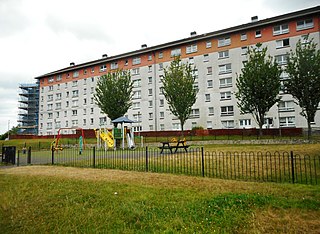
Darnley is an area in south-west Glasgow, Scotland, on the A727 just west of Arden. Other nearby neighbourhoods are Priesthill to the north, Southpark Village to the south, and South Nitshill and Parkhouse to the west; there is also a small industrial estate. The closest railway station is Priesthill and Darnley. The Brock Burn flows through the area.
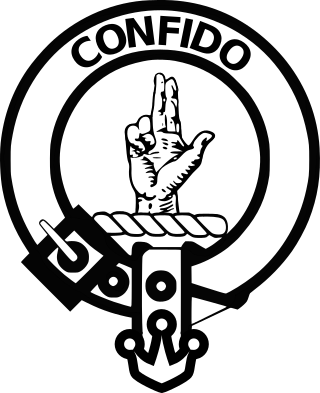
Clan Boyd is a Scottish clan of the Scottish Lowlands and is recognized as such by the Lord Lyon King of Arms.

Lennoxlove House is a historic house set in woodlands half a mile south of Haddington in East Lothian, Scotland. The house comprises a 15th-century tower, originally known as Lethington Castle, and has been extended several times, principally in the 17th, 19th and 20th centuries. The house is protected as a category A listed building, and is described by Historic Scotland as "one of Scotland's most ancient and notable houses." The wooded estate is included on the Inventory of Gardens and Designed Landscapes in Scotland, the national listing of significant gardens.
Stewart of Darnley, also known as the Lennox Stewarts, were a notable Scots family, a branch of the Clan Stewart, who provided the English Stuart monarchs with their male-line Stuart descent, after the reunion of their branch with the royal Scottish branch.

Clan Crichton is a Lowland Scottish clan that historically ruled Dumfries.

Clan Lennox is a Lowland Scottish clan. The clan chiefs were the original Earls of Lennox, although this title went via an heiress to other noble families in the fifteenth and sixteenth centuries. The chiefship of the clan then went to the Lennox of Woodehead branch.

Clan Haldane is a Lowland Scottish clan.

Clan Stewart is a Scottish Highland and Lowland clan. The clan is recognised by Court of the Lord Lyon; however, it does not have a Clan Chief recognised by the Lord Lyon King of Arms. Because the clan has no chief it can be considered an armigerous clan; however, the Earls of Galloway are now considered to be the principal branch of this clan, and the crest and motto of The Earls of Galloway's arms are used in the Clan Stewart crest badge. The Court of the Lord Lyon recognises two other Stewart/Stuart clans, Clan Stuart of Bute and Clan Stewart of Appin. Clan Stuart of Bute is the only one of the three clans at present which has a recognised chief.
The Battle of Carberry Hill took place on 15 June 1567, near Musselburgh, East Lothian, a few miles east of Edinburgh, Scotland. A number of Scottish lords objected to the rule of Mary, Queen of Scots, after she had married the Earl of Bothwell, who was widely believed to have murdered her previous husband Lord Darnley. The Lords were intent to avenge Darnley's death. However, Bothwell escaped from the stand-off at Carberry while Queen Mary surrendered. Mary abdicated, escaped from prison, and was defeated at the battle of Langside. She went to exile in England while her supporters continued a civil war in Scotland.

Clan Crawford is a Scottish clan of the Scottish Lowlands. The clan is of Scandinavian and Anglo-Saxon origin. There was in the early 18th century a mistaken belief that the clan had Norman origins. While historically recognised as a clan by the Court of the Lord Lyon, it is now an armigerous clan as it no longer has a chief. The last chief was Hugh Ronald George Craufurd, who sold his land and moved to Canada in 1904. He died in Calgary in 1942, leaving no male heirs.

Stobo Castle is located at Stobo in the Scottish Borders, in the former county of Peeblesshire. The Manor of Stobo was originally owned by the Balfour family. It became the family seat of the Graham-Montgomery Baronets from 1767. The building of the present castle began in 1805 and was completed in 1811 under the supervision of architects Archibald and James Elliot. It is currently operated as a health spa. The house is protected as a category A listed building, while the grounds are included in the Inventory of Gardens and Designed Landscapes in Scotland, the national listing of significant parks and gardens.

The Cunninghams of Drumquhassle were a family of the landed gentry in Scotland from the early 16th century to the mid-17th. They are linked to the Cunninghams of Kilmaurs in Ayrshire, being descended through junior lines via the Cunninghams of Polmaise. At their greatest extent, their lands included Mugdock-Mitchell and the house at Killermont, covering the part of parishes of Strathblane and New Kilpatrick. John Cunningham, the third laird held several positions of responsibility within the Scottish court, including Master of the Royal Household for James VI and a Collector General of tax during the regency of the Earl of Lennox, but his involvement in the power struggles between the Scottish nobility and the court of Elizabeth I of England also led to his demise and he was executed for treason in 1585. Over the next century, the family lost its land and power – in the mid-17th century, the Cunninghams sold their country house in Drumquhassle in rural Stirlingshire and it passed to the Govane family.

